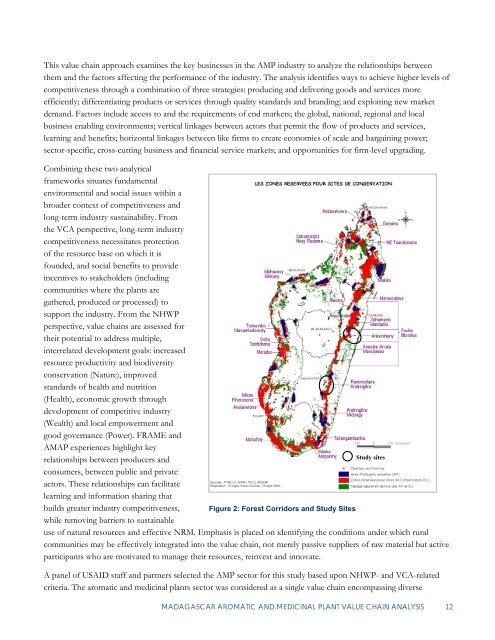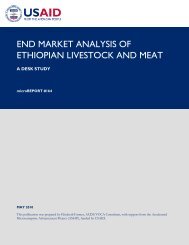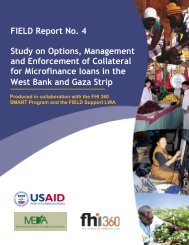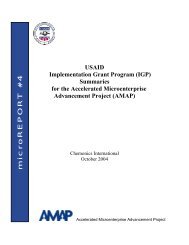Madagascar Aromatic and Medicinal Plants Value - Microlinks
Madagascar Aromatic and Medicinal Plants Value - Microlinks
Madagascar Aromatic and Medicinal Plants Value - Microlinks
Create successful ePaper yourself
Turn your PDF publications into a flip-book with our unique Google optimized e-Paper software.
This value chain approach examines the key businesses in the AMP industry to analyze the relationships between<br />
them <strong>and</strong> the factors affecting the performance of the industry. The analysis identifies ways to achieve higher levels of<br />
competitiveness through a combination of three strategies: producing <strong>and</strong> delivering goods <strong>and</strong> services more<br />
efficiently; differentiating products or services through quality st<strong>and</strong>ards <strong>and</strong> br<strong>and</strong>ing; <strong>and</strong> exploiting new market<br />
dem<strong>and</strong>. Factors include access to <strong>and</strong> the requirements of end markets; the global, national, regional <strong>and</strong> local<br />
business enabling environments; vertical linkages between actors that permit the flow of products <strong>and</strong> services,<br />
learning <strong>and</strong> benefits; horizontal linkages between like firms to create economies of scale <strong>and</strong> bargaining power;<br />
sector-specific, cross-cutting business <strong>and</strong> financial service markets; <strong>and</strong> opportunities for firm-level upgrading.<br />
Combining these two analytical<br />
frameworks situates fundamental<br />
environmental <strong>and</strong> social issues within a<br />
broader context of competitiveness <strong>and</strong><br />
long-term industry sustainability. From<br />
the VCA perspective, long-term industry<br />
competitiveness necessitates protection<br />
of the resource base on which it is<br />
founded, <strong>and</strong> social benefits to provide<br />
incentives to stakeholders (including<br />
communities where the plants are<br />
gathered, produced or processed) to<br />
support the industry. From the NHWP<br />
perspective, value chains are assessed for<br />
their potential to address multiple,<br />
interrelated development goals: increased<br />
resource productivity <strong>and</strong> biodiversity<br />
conservation (Nature), improved<br />
st<strong>and</strong>ards of health <strong>and</strong> nutrition<br />
(Health), economic growth through<br />
development of competitive industry<br />
(Wealth) <strong>and</strong> local empowerment <strong>and</strong><br />
good governance (Power). FRAME <strong>and</strong><br />
AMAP experiences highlight key<br />
relationships between producers <strong>and</strong><br />
Study sites<br />
consumers, between public <strong>and</strong> private<br />
actors. These relationships can facilitate<br />
learning <strong>and</strong> information sharing that<br />
builds greater industry competitiveness, Figure 2: Forest Corridors <strong>and</strong> Study Sites<br />
while removing barriers to sustainable<br />
use of natural resources <strong>and</strong> effective NRM. Emphasis is placed on identifying the conditions under which rural<br />
communities may be effectively integrated into the value chain, not merely passive suppliers of raw material but active<br />
participants who are motivated to manage their resources, reinvest <strong>and</strong> innovate.<br />
A panel of USAID staff <strong>and</strong> partners selected the AMP sector for this study based upon NHWP- <strong>and</strong> VCA-related<br />
criteria. The aromatic <strong>and</strong> medicinal plants sector was considered as a single value chain encompassing diverse<br />
MADAGASCAR AROMATIC AND MEDICINAL PLANT VALUE CHAIN ANALYSIS 12





